Japanese Wagashi: Artful Delights Of Traditional Confectionery
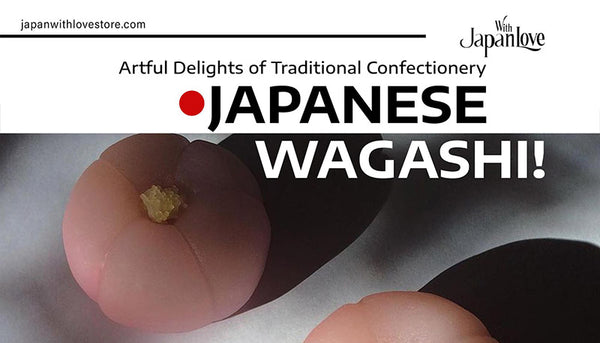
The Land of the rising sun - Japan is famous for its diverse and unique cuisine. One of them is Wagashi cake. Japanese Wagashi is a beloved Japanese snack that typically features sweets crafted from sugar, syrup, and "an" (sweet red bean paste). Additionally, you can afind delectable treats flavoured with salt and soy sauce, including enbei and arare (rice cakes) and dango (dumplings). Wagashi cakes have been an integral part of Japanese culture for centuries and are often served during tea ceremonies or as a sweet treat for special occasions. Let's find out the interesting things surrounding this traditional cake with Japan With Love Store.
1. What is Wagashi?
The history of Wagashi can be traced back to ancient times in Japan. The roots of Wagashi can be found in Buddhist rituals and tea ceremonies, where the offering and consumption of sweets played an important role.
The introduction of sugar and refined sweets from China during the Nara period (710-794) Inspired the development of Wagashi. However, Japanese Wagashi was during the Edo period (1603-1868) that Wagashi began to take on its distinct characteristics and regional variations.
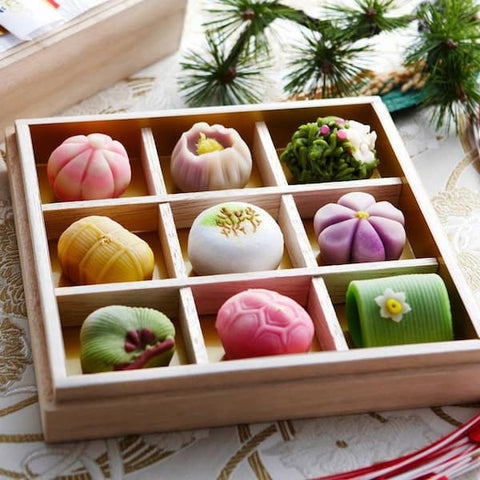
A well-loved Japanese sweet is Wagashi
During the Meiji period (1868-1912), the term wagashi was created as a way to differentiate Japanese sweets from the European ones that were being imported into Japan. What does wagashi taste like? The texture of these treats is delightfully soft and fluffy with a hint of sweetness. The shapes of these sweets were originally inspired by Chinese confections and dim sum, but wagashi has since evolved to become more expressive and uniquely Japanese.
Wagashi's connection to the tea ceremony further enhanced its status as an art form. Wagashi's minimalist and harmonious nature is consistent with the aesthetic principles of the tea ceremony, emphasizing simplicity, beauty, and mindfulness.
Today, Wagashi Japanese continues to be enjoyed as a delightful dish and an expression of Japanese culture. It is often served with green tea or enjoyed as a standalone dessert that is appreciated not only for its taste but also for its craftsmanship and cultural significance.
2. Ingredients of Wagashi
To make Wagashi, a variety of ingredients are used, depending on the specific type of Wagashi Japanese being prepared. However, here are some common ingredients found in many Wagashi recipes:
- Sweet Bean Paste (Anko): An essential component of Wagashi, sweet bean paste is typically made from cooked and sweetened azuki beans. There are different types of Anko, including smooth (koshi-an) and chunky (tsubu-an), offering a range of textures.
- Rice Flour: Rice flour, often glutinous rice flour (mochiko), is used to make the outer dough or wrapping of certain Wagashi. It provides a soft and chewy texture.
- Sugar: Sugar is used to sweeten the bean paste and other components of Wagashi. It can be added to the bean paste during the cooking process or sprinkled on the outer surface.
- Agar or Gelatin: These gelling agents are sometimes used to give shape and structure to certain types of Wagashi. They help create a firm and jelly-like texture.
- Matcha (Powdered Green Tea): Matcha is often incorporated into Wagashi, adding a vibrant green color and a subtle, earthy flavor. It is used in dough, fillings, or for dusting the outer surface.
- Fruits and Natural Flavorings: Some Wagashi feature fruits like sakura (cherry blossoms), yuzu (citrus), or chestnut as flavorings or garnishes. These ingredients infuse the confections with unique and refreshing tastes.
- Soybean Flour (Kinako): Kinako, roasted soybean flour, is commonly used as a coating for Wagashi. It adds a nutty flavor and enhances the overall texture.
These are just a few examples of the ingredients used in Wagashi. Different types of Japan Wagashi may incorporate additional ingredients such as sesame seeds, agar-agar, edible flowers, or even sake lees, resulting in a wide variety of flavours and textures.
3. Etiquette and Tools for Enjoying Wagashi
Japan Wagashi sweets are best paired with green tea. However, there are specific rules to observe when consuming these confections, depending on the occasion. During formal ceremonies, wagashi is served on small individual plates or in a large flat bowl for multiple guests.
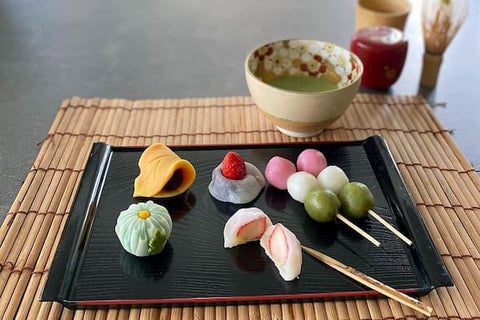
Wagashi is often served with green tea by the Japanese
To properly enjoy wagashi, Japanese culture utilizes traditional utensils like Kuromoji and Youji. These flat tools, resembling miniature knives, are used to slice and pick up the sweets. Stainless steel is the primary material used to make Youjis, whereas Kuromojis are made of wood.
Remember to exercise patience even when you're enticed to indulge in the wagashi. It's important to wait for the tea server to say the words "Wagashi o Douzo" (Please enjoy the sweets) before starting to consume them.
4. Types of Wagashi
Wagashi comes in many shapes, sizes, and flavours, with unique variations found in different regions and seasons. Here are some of the most popular types to suit every taste and preference.
4.1. Dango
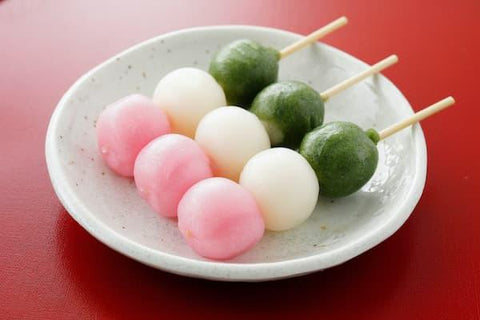
Dango are small steamed mochi cakes served on a skewer of three or four dumplings.
Dango is the most common type of wagashi. These chewy round mochi balls on a stick are covered in a sweet-salty syrup made of soy sauce, sugar, and starch. You can find them all year round at festivals or convenience stores.
4.2. Daifuku
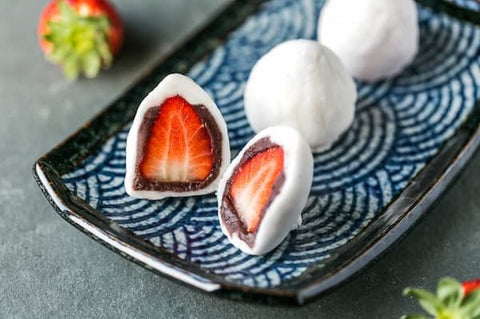
Daifuku is usually sold as a limited-edition product for one season from winter to spring
Daifuku is a small round mochi stuffed with a sweet filling, usually red bean paste. The name literally translates into “great luck” so daifuku mochi is “great luck rice cake”. It comes in many flavors, with the most common being ichigo (strawberry) daifuku and mame (soybean) daifuku.
4.3. Manju

Manju is a round steamed cake usually filled with sweet red bean paste.
Manju is a pastry coated with kneaded dough and filled with flavored ingredients like anko, chestnut jam, or sweet potato. It is usually steamed and varies by region.
4.4. Dorayaki

Sweet red bean paste is essential for Dorayaki
Dorayaki is a cake made of sweet red bean paste sandwiched between two layers of fluffy sponge cake. The name “dora” in Japanese means gong, reflecting its shape, and “yaki” means bake.
4.5. Namagashi
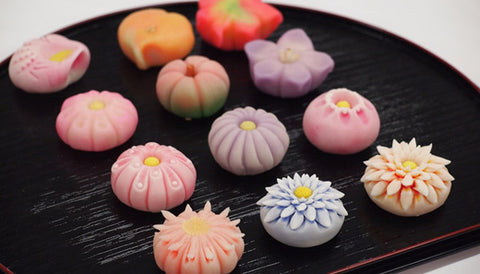
Namagashi is shaped differently and beautifully
Namagashi is a type of wagashi that is considered an edible piece of art, with beautiful seasonal designs such as flowers and leaves. It is especially popular during Japanese tea ceremonies and is the most delicate of all wagashi types, requiring daily preparation and consumption while fresh.
4.6. Taiyaki
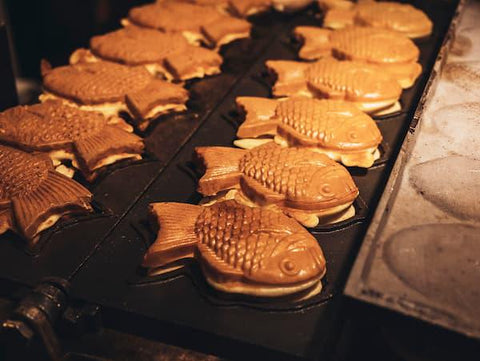
Others Taiyaki include custard, cheese, or chocolate ice cream.
Taiyaki is a Japanese fish-shaped cake, resembling the red sea bream fish. Traditionally, it is filled with anko red bean paste but you can find Taiyaki filled with chocolate, matcha, and even ice cream.
5. How to buy Wagashi?
Wagashi has become popular throughout Japan, and can now be easily found in a number of cafes, restaurants, temples, and gardens where tea is served. If you're visiting Kyoto, exploring the city's many traditional snack shops is a great way to experience wagashi.
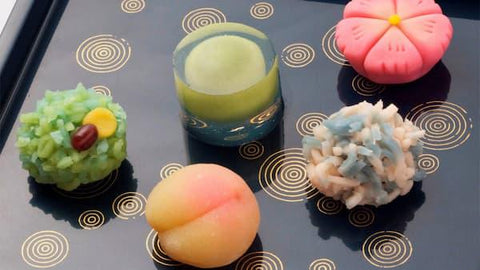
Wagashi is sold in many places in Japan
In Tokyo, the Nakamise shopping street in Asakusa is an ideal spot to sample these foods. They are also a popular gift choice to take back from business trips and can often be found in Japanese department stores located at major train stations.
For those who want to learn more about wagashi, there are many traditional wagashi-making classes taught by certified instructors. In these classes, participants can learn about the meaning behind wagashi and even enjoy the food of their own creation.

コメントを残す